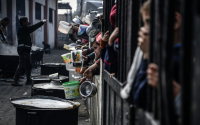4 October 2006,The Independent
Drought threatening the lives of millions will spread across half the land surface of the Earth in the coming century because of global warming, according to new predictions from Britain's leading climate scientists.
Extreme drought, in which agriculture is in effect impossible, will affect about a third of the planet, according to the study from the Met Office's Hadley Centre for Climate Prediction and Research.
It is one of the most dire forecasts so far of the potential effects of rising temperatures around the world - yet it may be an underestimation, the scientists involved said yesterday.
The findings, released at the Climate Clinic at the Conservative Party conference in Bournemouth, drew astonished and dismayed reactions from aid agencies and development specialists, who fear that the poor of developing countries will be worst hit.
"This is genuinely terrifying," said Andrew Pendleton of Christian Aid. "It is a death sentence for many millions of people. It will mean migration off the land at levels we have not seen before, and at levels poor countries cannot cope with."
One of Britain's leading experts on the effects of climate change on the developing countries, Andrew Simms from the New Economics Foundation, said: "There's almost no aspect of life in the developing countries that these predictions don't undermine - the ability to grow food, the ability to have a safe sanitation system, the availability of water. For hundreds of millions of people for whom getting through the day is already a struggle, this is going to push them over the precipice."
The findings represent the first time that the threat of increased drought from climate change has been quantified with a supercomputer climate model such as the one operated by the Hadley Centre.
Their impact is likely to even greater because the findings may be an underestimate. The study did not include potential effects on drought from global-warming-induced changes to the Earth's carbon cycle.
In one unpublished Met Office study, when the carbon cycle effects are included, future drought is even worse.
The results are regarded as most valid at the global level, but the clear implication is that the parts of the world already stricken by drought, such as Africa, will be the places where the projected increase will have the most severe effects.
The study, by Eleanor Burke and two Hadley Centre colleagues, models how a measure of drought known as the Palmer Drought Severity Index (PDSI) is likely to increase globally during the coming century with predicted changes in rainfall and heat around the world because of climate change. It shows the PDSI figure for moderate drought, currently at 25 per cent of the Earth's surface, rising to 50 per cent by 2100, the figure for severe drought, currently at about 8 per cent, rising to 40 cent, and the figure for extreme drought, currently 3 per cent, rising to 30 per cent.
Senior Met Office scientists are sensitive about the study, funded by the Department for Environment, Food and Rural Affairs, stressing it contains uncertainties: there is only one climate model involved, one future scenario for emissions of greenhouse gases (a moderate-to-high one) and one drought index. Nevertheless, the result is "significant", according to Vicky Pope, the head of the Hadley Centre's climate programme. Further work would now be taking place to try to assess the potential risk of different levels of drought in different places, she said.
The full study - Modelling the Recent Evolution of Global Drought and Projections for the 21st Century with the Hadley Centre Climate Model - will be published later this month in The Journal of Hydrometeorology .
It will be widely publicised by the British Government at the negotiations in Nairobi in November on a successor to the Kyoto climate treaty. But a preview of it was given by Dr Burke in a presentation to the Climate Clinic, which was formed by environmental groups, with The Independent as media partner, to press politicians for tougher action on climate change. The Climate Clinic has been in operation at all the party conferences.
While the study will be seen as a cause for great concern, it is the figure for the increase in extreme drought that some observers find most frightening.
"We're talking about 30 per cent of the world's land surface becoming essentially uninhabitable in terms of agricultural production in the space of a few decades," Mark Lynas, the author of High Tide, the first major account of the visible effects of global warming around the world, said. "These are parts of the world where hundreds of millions of people will no longer be able to feed themselves."
Mr Pendleton said: "This means you're talking about any form of development going straight out of the window. The vast majority of poor people in the developing world are small-scale farmers who... rely on rain."
A glimpse of what lies ahead
The sun beats down across northern Kenya's Rift Valley, turning brown what was once green. Farmers and nomadic herders are waiting with bated breath for the arrival of the "short" rains - a few weeks of intense rainfall that will ensure their crops grow and their cattle can eat.
The short rains are due in the next month. Last year they never came; large swaths of the Horn of Africa stayed brown. From Ethiopia and Eritrea, through Somalia and down into Tanzania, 11 million people were at risk of hunger.
This devastating image of a drought-ravaged region offers a glimpse of what lies ahead for large parts of the planet as global warming takes hold.
In Kenya, the animals died first. The nomadic herders' one source of sustenance and income - their cattle - perished with nothing to eat and nothing to drink. Bleached skeletons of cows and goats littered the barren landscape.
The number of food emergencies in Africa each year has almost tripled since the 1980s. Across sub-Saharan Africa, one in three people is under-nourished. Poor governance has played a part.
Pastoralist communities suffer most, rather than farmers and urban dwellers. Nomadic herders will walk for weeks to find a water hole or riverbed. As resources dwindle, fighting between tribes over scarce resources becomes common.
One of the most critical issues is under-investment in pastoralist areas. Here, roads are rare, schools and hospitals almost non-existent.
Nomadic herders in Turkana, northern Kenya, who saw their cattle die last year, are making adjustments to their way of life. When charities offerednew cattle, they said no. Instead, they asked for donkeys and camels - animals more likely to survive hard times.
Pastoralists have little other than their animals to rely on. But projects which provide them with money to buy food elsewhere have proved effective, in the short term at least.
Steve Bloomfield






